
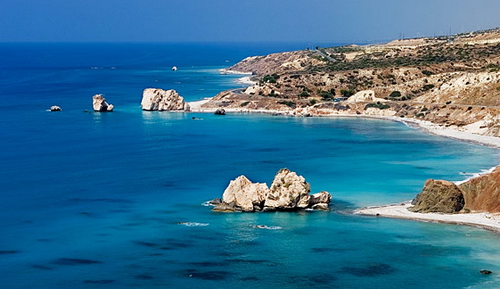
Cyprus - an island of legends, all year
round surrounded by the dazzling rays of the Mediterranean sun.
Today Cyprus effortlessly combines European culture and charm "with
ancient" ... You will be presented of alluring beaches and fragrant
mountain peaks, stir the imagination of the ancient ruins and monuments,
vineyards and olive groves, citrus groves and old stone villages ...
The island of Cyprus is located in West Asia and the Mediterranean
basin. Nearest continental neighbors - Turkey (65 km), Syria (95 km),
Egypt (380 km). Cyprus is the third largest island in the Mediterranean
Sea (after Sicily and Sardinia). The total area of Cyprus is 9.251
thousand square meters. km (including 3,350 thousand square meters. km.
occur in the so-called Northern Cyprus).
The length of the island from east to west - 224 km from north to south
- 96 km. The coastline of the island heavily indented and is an
alternation of rocky areas with sandy coves. The island is quite
diverse. There is a flat land, forests and mountains. In the north of
the island is Kyrenia mountain range. In the south it stretches parallel
to another mountain range - Troodos Mountains. The highest point - Mount
Olympos (1.951 m).
Climate in Cyprus
Cyprus - a prime
example of a place with unusually healthy, wholesome Mediterranean
climates. Speaks for itself the number of sunny days per year: 330-340.
Especially abundant sunshine from April to September (bright sunshine 11
hours a day). True, the rest is the best season, from May to November.
The Cyprus government alert to the environment, and the authorities'
efforts to justify themselves: it extremely clean and the sea, and air.
In February in Cyprus the first signs of spring. On the mountain slopes,
in the yellow-green trva, spring bloom white and blue flowers in the
valleys of the field is covered with a green carpet, life begins to
simmer in the orchards and vineyards. Lemon blossoms and jasmine, with
the noise and clatter of rushing river gorges.
In mid-May in Cyprus comes dry, hot summer. This season lasts until
October. Summer is really hot - up to 40 � C in the shade. Even in
October under the sun so you can get burnt.
Not surprisingly, by the end of this hot in Cyprus eagerly awaiting the
first rains. This means that the autumn came. True, in the fall of our
middle band is completely different. It's - it's time to bloom and
greenery. Lush green covers the slopes of the mountains, and begin to
bud carnations, buttercups, cyclamen and hyacinths.
Winter in Cyprus, of course, also is not like ours. There is rarely
colder 15 � C. January while the coldest month of the Cyprus winter.
Winter in Cyprus often rains and cloudy days, but the sun is not so
rare.
Snow in Cyprus can only be seen in the mountains. On the Troodos
mountain range is snow from December to October, and it is enough for
skiing. By the way, winter sports on the island of love - except skiing,
here are addicted to skating, hockey, skating and so on. But winter at
Troodos perfectly coexists with sunny beaches, and stay warm in the
winter, covered with evergreens - eucalyptus and palm trees. In winter,
the water temperature is not above the sea 17-18 � C, but quite a few
vacationers swim well, not just sunbathing. Therefore, this winter could
be compared more to do with "Indian Summer."
Traditions of Cyprus
Cypriots love the
holidays, which is celebrated on the island set, and mark them with
special solemnity. In addition to national (civil) and religious
festivals, in every town and almost every village on certain days or
weeks of the year held their own local events, festivals and carnivals.
In the villages, preserved many ancient customs and rituals. These
special days there and in the monasteries. For example, each of which
celebrates the birth of its patron saint. On this day, the monastery
walls unfold panigirii - religious fair. Foods and sweets - the seller
holiday trade. Cypriots - Orthodox Christians, during the year they
celebrate many religious holidays. Three of them - especially the
well-known: it is Easter, the Annunciation and the Assumption of the
Blessed Virgin.
Very popular among both Cypriots and tourists alike enjoy held in
September in Limassol Wine Festival. It lasts several days and is
accompanied by folk music, folk ensembles and free wine straight from
the barrels. The holiday program includes a tasting of wines of Cyprus,
concerts and theatrical performances, contests, singers and dancers.
The traditions of the island date back to ancient times and continues to
this day. One of them - the extraordinary hospitality and cordiality
Cypriots, who are glad to see visitors from all countries.
During national holidays closed government offices, banks, government
agencies, private firms, commercial establishments. Only in the resorts
operate some stores. If January 1, March 25, May 1 and October 1 falls
on a Sunday, the following Monday - a day.
Attractions in Cyprus
Akamas nature reserve
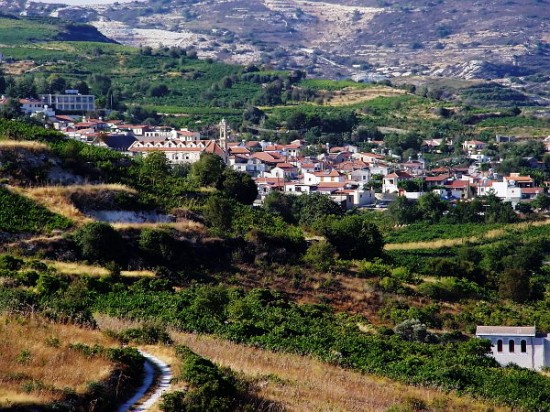
Akamas nature reserve located near the town of Paphos, the historical and cultural capital of the western part of the island. Here, Aphrodite is said to have equipped his bath for romantic meetings, and of course, the Baths of Aphrodite are a compulsory part of any individual or group excursions road trip. It is believed that one dip in the pool with this natural spring water finds beauty for years to come. However, the Cypriot authorities have banned bathing in the holy place (this prevents the corresponding plate), wishing, perhaps, to save many tourists from possible disappointment. However, about washing is silent, and visitors, especially women, use it.
Kolossi Castle
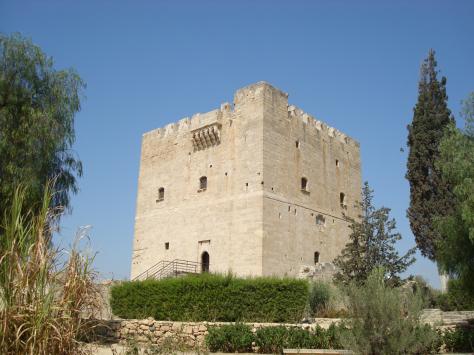
Kolossi Castle - one of
the major attractions of Cyprus. The castle is located about 10 km west
of Limassol. The castle was built in 1454, when the Commander Louis de
maniac. Three-story castle tower height of almost 25 m has a wall
thickness of 2.5 m at the entrance to the castle drawbridge and
immediately fell into the living room of the second floor. On the third
floor are rooms of the commander. Downstairs in the basement, there were
wells.
In the courtyard of the castle attract attention giant cypress and
spreading, gnarled with age tree "mahaerium." Arranged on the roof
observation deck - hence clearly visible fields, vineyards and orange
plantations and the road, and behind them - the sea and Limassol.
Kouklia
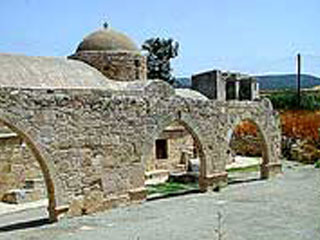
In the village of Kouklia,
built on the ruins of the ancient Palea Paphos, is the most important in
the ancient world, the sanctuary of Aphrodite. He is referred to the
ancient Greek historian Homer. It attracts thousands of pilgrims. Local
beliefs prescribed to women after Aphrodite at least once to have sex
with a stranger. It is believed that in the temple of Aphrodite, and
there were mass orgy. The tradition of such an unusual way of worshiping
the goddess was nullified only in the IV. BC with the establishment of
Christianity, with its more stringent moral principles. Temple gradually
collapsed. At Lusignan stone of its walls was used for the construction
of sugar factories.
The museum is located in the castle, built by the Lusignan. The most
interesting visitors are usually black polished stone phallic shape
(symbol of Aphrodite, love, fertility) and a unique collection of
Cypriot syllabic and Greek inscriptions.
Cities in Cyprus
Nicosia
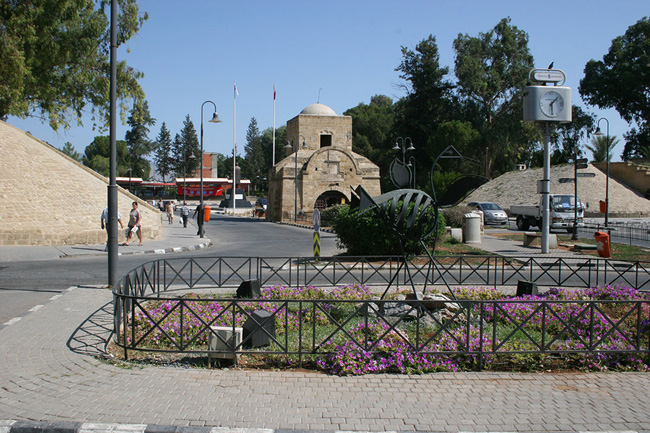 Nicosia - the
capital of the Republic of Cyprus, the cultural and financial center of
the island. Here are the residence of the President of the Republic of
Cyprus and the Archbishop (senior hierarch of the Cyprus Church), the
Parliament, ministries, offices of large companies. This, moreover, is
the largest city of Cyprus. Its population is about 200 000 people.
Nicosia - the
capital of the Republic of Cyprus, the cultural and financial center of
the island. Here are the residence of the President of the Republic of
Cyprus and the Archbishop (senior hierarch of the Cyprus Church), the
Parliament, ministries, offices of large companies. This, moreover, is
the largest city of Cyprus. Its population is about 200 000 people.
The exact number can not be called because the opinions of who can be
considered resident in northern and southern Cypriots apart. About
three-quarters of the urban population (the Greek Cypriots) living in
the south, about a quarter (Turkish Cypriots) - in the north. The
demarcation line that southern Cypriots flatly refuse to call the
"boundary" is not only a new city, but also in the very center of the
Old Town, is still completely enclosed by medieval walls. This
demarcation line is also referred to as (the "Green Line"): The name
caught on since then, in 1963, after the first clashes between the two
ethnic groups, the British officers laid her on the ground and caused
the plan of green pencil.
Nicosia lies in the interior of the island of Cyprus in the fertile
valley of Mesaoria, between two mountain ranges - Troodos and Kyrenia.
Divided into two parts, Nicosia is also the capital of the Republic of
Cyprus and the center of the Turkish Northern Cyprus. In Turkish Nicosia
called Lefkosa. Greek Cypriots call their capital Lefkosia.
From about X century, during the reign of the Byzantine Empire, the
status of the city began to grow - primarily due to its distance from
the coast, which has become unsafe because of pirates from the
continent. As elsewhere in Cyprus, in Nicosia rulers alternated
frequently: once ruled by the Byzantine Catholic Lusignan, and then the
city has experienced almost three hundred-year Ottoman yoke.
Nicosia is a very ancient city, throughout history there have been
periods of decline and rebirth, often changed its rulers. In the city
center there are numerous historical and architectural monuments, which
have retained the imprint of the ancient years and all the tests that
had to go through Nicosia.
The capital of Cyprus is interesting primarily for its ancient
buildings. The largest and oldest of them - the "old town", which is
located in the heart of Nicosia. It is surrounded by majestic walls and
bastions in the shape of hearts, that his vain loopholes look down on
tourists and preserve the traces of former times.
In the "old town" special attention should be paid to the Laiki Gethin
quarter, which was restored and today is open only to pedestrians. On
its narrow streets can be found in a large variety of souvenir shops,
shops, restaurants and taverns.
Limassol
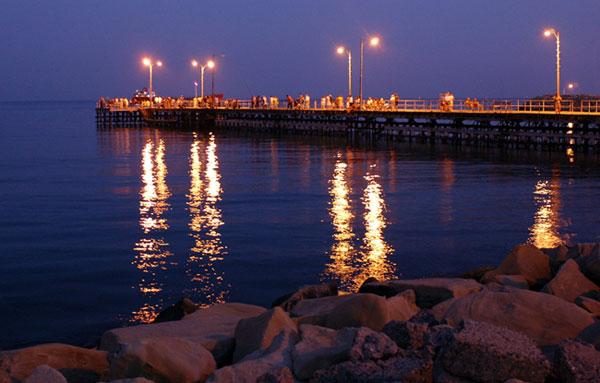 Limassol is
the second largest city and a major resort center of Cyprus, which lies
on the south bank. Limassol is the most fun and "kosmopolitskim" city, a
favorite as "you like this" youth and family vacationers and respectable
people. Limassol is perfect for those who come to Cyprus for the first
time and wants to see the major regions of the island. This is the
"Russian-speaking" resort island. Limassol is about 45 minutes drive
from Larnaca Airport.
Limassol is
the second largest city and a major resort center of Cyprus, which lies
on the south bank. Limassol is the most fun and "kosmopolitskim" city, a
favorite as "you like this" youth and family vacationers and respectable
people. Limassol is perfect for those who come to Cyprus for the first
time and wants to see the major regions of the island. This is the
"Russian-speaking" resort island. Limassol is about 45 minutes drive
from Larnaca Airport.
In the vicinity of the old town of Limassol Cyprus Amathus and Kourion,
once used by the ancient city-states. To the north of the resort are
beautiful Troodos Mountains with shelter in the pine forests of ancient
monasteries. Nearby is the Kolossi Castle, in some periods of the former
residence of the rulers of the country. Also in Limassol has the famous
citadel, built in the beginning of the XIV century on the ruins of the
Byzantine castle, in the chapel which was the marriage between Richard
the Lionheart and Berengaria, who later became the Queen of England. Now
located in the citadel of the Cyprus Medieval Museum. Well known as the
Church of Ayia Napa, which is a relic of St. veil. Veronica, which she
handed to Christ on the way to the crucifixion.
Larnaca
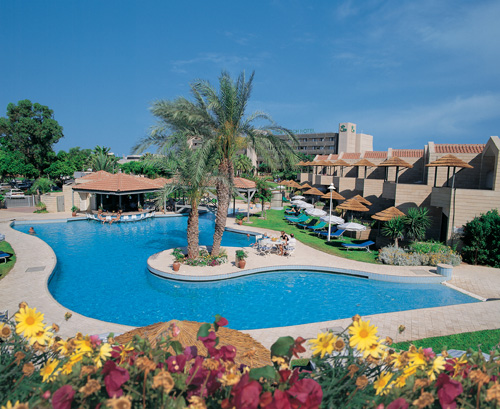 Larnaca - the
third largest, after Nicosia and Limassol, a city of Cyprus. It is
located on the southeast coast, about 70 km from Limassol. Very nice
town, and nesuetny quiet, but nevertheless, having everything you need
for a busy holiday. The presence of the international airport, which
flies most of the flights from Russia, makes the city an ideal place for
those who do not want after a 3-hour flight and still take a bus to
another town.
Larnaca - the
third largest, after Nicosia and Limassol, a city of Cyprus. It is
located on the southeast coast, about 70 km from Limassol. Very nice
town, and nesuetny quiet, but nevertheless, having everything you need
for a busy holiday. The presence of the international airport, which
flies most of the flights from Russia, makes the city an ideal place for
those who do not want after a 3-hour flight and still take a bus to
another town.
Despite some "provincial" Larnaca, compared to, for example, Limassol,
in the mass of attractions and entertainment. Among the former is the
beautiful port fortress, built by the Turks in the XVII century., Its
territory is a small museum of the history of Larnaca, which collects
archaeological finds from the Bronze Age and the ancient Kition to XX
century. But the main cultural value of Larnaca, of course, the Church
of St. Lazarus, built in the IX century. over the grave of the saint.
Interesting and will visit the private museum Peridesa, which contains
items of local life of several centuries. Other points of interest are
curious Archaeological Museum, the ancient Acropolis, the excavation of
ancient Kition, Hala Sultan Tekke mosque on a salt lake, where,
according to legend, buried a relative of the Prophet Muhammad. And in
the town of Kitty, 11 km from the city, the church was found by one of
the ancient mosaics of the whole Christian world. If we consider more
than the compact size of the city, sightseeing will not tire even the
most relaxed sun tourist.
The famous promenade Finikudis ("Palm Avenue") is separated from the
edge of the quiet lapping of waves for a few tens of meters. Its
attraction is the avenue of tall and slender palm, rows of restaurants,
bars and fast-food restaurants, disco clubs and dance halls. Walking
through the very center of the city, with its narrow streets confused
between the old low houses - will take a real pleasure. A pleasant walk
combined with shopping, it is from the center and the city market, where
they sell the cheapest in fruits, gifts and wine, are two parallel
streets lined with boutique shops.
Today the city is built on land that holds the ruins of the ancient
city-state of Kition. It is known that this is where the port Kition -
Phoenician stronghold and a thriving commercial center. The first
impression travelers get a little after driving from Larnaca
International Airport - leave no one indifferent look of a beautiful
lake with pink flamingos, where the winter months are a shelter mass
migratory birds. The old town has retained its oriental flavor. And in
the modern part of it offers comfortable hotels, equipped so that you
can spend all day at the hotel, especially since many of them are
located on the beach and most hotels, numerous recreational activities,
and in the evenings playing their own orchestras. Larnaca - is the
perfect place for shopping and nightlife with many bars and clubs.
Pathos
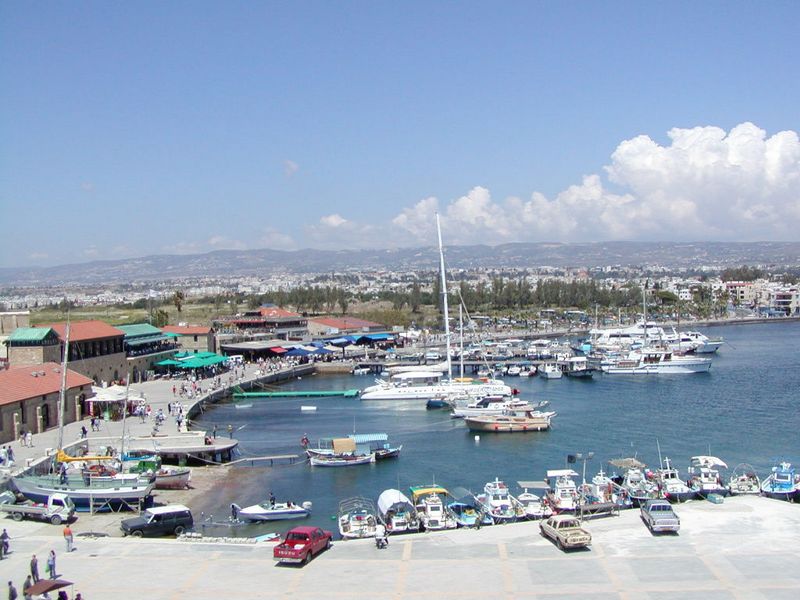 Pleasant port
city for many centuries was the capital of Cyprus, has always attracted
the rest of the island residents and foreigners. Numerous monuments
located in the center of the modern city, in a small picturesque port
and along the coast, is listed as the world cultural heritage. In the
area of Paphos on the sea born goddess of love and beauty Aphrodite.
Pleasant port
city for many centuries was the capital of Cyprus, has always attracted
the rest of the island residents and foreigners. Numerous monuments
located in the center of the modern city, in a small picturesque port
and along the coast, is listed as the world cultural heritage. In the
area of Paphos on the sea born goddess of love and beauty Aphrodite.
There are numerous villages, the way of life that has not changed over
time. In inland areas are famous monasteries. Paphos - a unique tourist
center and spa, but, in contrast to the recently published resorts,
attracting more and its two thousand years of history. In the south, on
the coast, located settlement of Kato Paphos with numerous luxury
hotels, private beaches and a huge swimming pool, where tourists come
from all over the world, and where, in spite of the high-rise buildings,
there remains a comfortable family-friendly atmosphere. You have the
opportunity to visit the treasury, keeping the memory of thousands of
years, to see the burial of kings, the remains of an ancient village
near Paphos Kouklia Ayios Neophytos Monastery frescoes.